Guest Editorial: Friends and the Vegetarian Way
By Robert Heckert
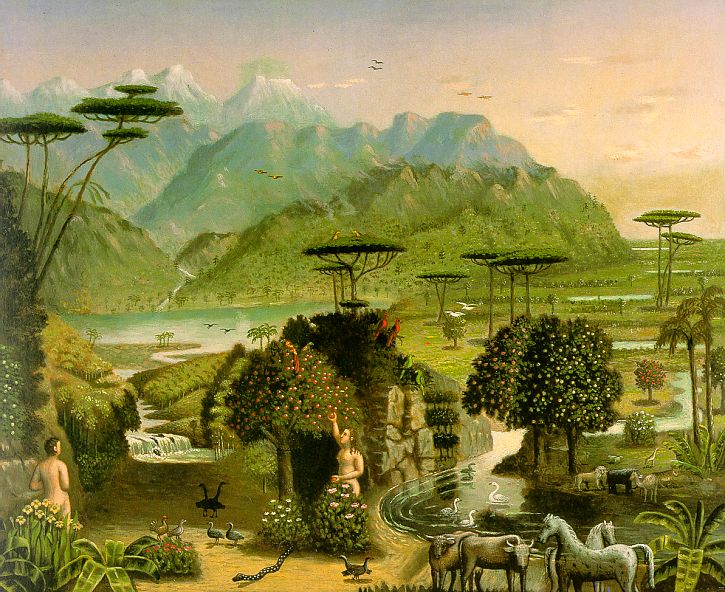
With few exceptions, Friends, though noted for their principle and practice of nonviolence, have not treated certain animals and other warm-blooded creatures in a nonviolent manner. Along with tens of millions throughout the world, they think it is perfectly justifiable to kill billions of creatures annually to satisfy taste and appetite, to relieve hunger. And so our slaughterhouses are kept busier than ever, usually beyond sight of the people who consume the meat. These people are blissfully unaware of the cruelty and suffering perpetrated upon hapless creatures, which have the right to live out their natural span of life.
Vegetarianism has its biblical sanction in the first chapter of Genesis, verse 29: "God also said, 'I give you all plants that bear seed everywhere upon the earth . . . they shall be yours for food.'" (New English Bible) Genesis goes on to say that humans were to rule the fish in the sea, the birds of heaven, all the animals and reptiles, but not to eat them. It was the golden age of peace in the world, celebrated in primitive legends, when there was neither war nor bloodshed and humans lived in friendly companionship with the other creatures of the earth.
But then something happened . . . . To keep alive in the cold regions in the absence of non-flesh food, humans took to eating fish and animals. A virtue was made of necessity. Human beings eventually became caretakers and breeders of animals for food on a greater and greater scale. It seems that from about 6000 B.C. domestication of meat animals and organized war went hand in hand.
Ethically, the only justification for the practice of meat-eating--namely, necessity--is no longer valid. Today, with our vast transportation system, efficient refrigeration, and storage systems, food of plant origin, including trees, is certain and available to all, at least in the U.S.
But it is widely asserted and assumed that consumption of meat and fish is essential to maintain health and strength. This is absolutely false. In the September 1981 Reader's Digest is found an article, "How Healthy Is a Vegetarian Diet?" by Jane Brody, food and nutrition editor of the New York Times. She declares, "In recent years, the meatless way of life has surged in popularity, largely because increasing evidence indicates that a sensible vegetarian diet is better for you than the typical meat-heavy American one."
She goes on to detail how a vegetarian diet "protects your heart, controls your weight, and reduces the risk of cancer." It promotes longevity. Jane Brody points out that the human body is not designed for meat-eating. "Our anatomical equipment--teeth, jaws, digestive system--favors a diet that emphasizes plant foods."
Flesh-eating produces horrible, putrefactive fermentation in the system . . . . Many animals are afflicted with disease and parasites. They pass through careless, and often corrupt, government inspection, and are eaten by humans, causing untold misery. There are the chemicals in the fish, such as lead, mercury, and cadmium, which are deadly. Then there are the chemical additives like sodium nitrate and sodium nitrite, as well as dangerous hormones such as DES.
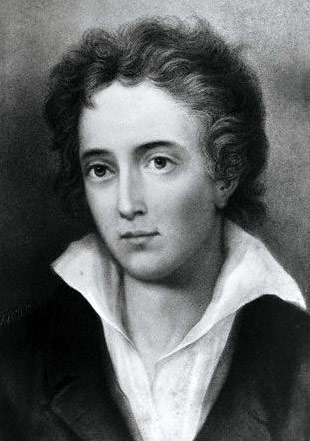 For about 36 years I have practiced the vegetarian way of life, and I thank God for what it has done for me. It has given me a light and clear head, a tranquil body and spirit. I have never experienced a single day of sickness or even a slight indisposition. At 78 I continue to work regularly at an editorial job. I can walk long distances, covering 20 miles in less than five hours
For about 36 years I have practiced the vegetarian way of life, and I thank God for what it has done for me. It has given me a light and clear head, a tranquil body and spirit. I have never experienced a single day of sickness or even a slight indisposition. At 78 I continue to work regularly at an editorial job. I can walk long distances, covering 20 miles in less than five hours 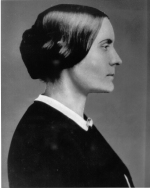 with relative ease. I rejoice in being in the company of such great men of history as Socrates, Plato, Zoroaster, Buddha, Jesus, Leonardo da Vinci, Franklin, Newton, Shelley, Tolstoy, Gandhi, . . . and I believe at least one outstanding woman, Susan B. Anthony, a Quaker.
with relative ease. I rejoice in being in the company of such great men of history as Socrates, Plato, Zoroaster, Buddha, Jesus, Leonardo da Vinci, Franklin, Newton, Shelley, Tolstoy, Gandhi, . . . and I believe at least one outstanding woman, Susan B. Anthony, a Quaker.
How many Friends in the U.S. and Canada know that since 1902 there has existed in England a flourishing Friends Vegetarian Society functioning within London Yearly Meeting? I came in touch with them a few years ago. Terence Lane, the secretary, tried his best to encourage me to move toward the formation of a similar society in this country. I did conscientiously take some steps in that direction, but I was unable to find any Friends who were willing and able to devote time to such an endeavor. I gave up the effort. Perhaps one or more Friends who see this article will be moved to take up the torch. I would be glad to hear from them.
In 1978, during Philadelphia Yearly Meeting, a concern of mine about the colossal scale of slaughter of animals for food was read by the clerk. No discussion from the floor was opened, and of course no action was taken on that concern. It was sad for me, and I think sad for the Religious Society of Friends. I look forward with hope to a better day, when Philadelphia and other yearly meetings will join that blessed vanguard of humanity who champion the vegetarian way of life for the sake of humanitarianism, good health, and a more intelligent ordering and use of our precious land.
© 1982 Friends Publishing Corporation. Reprinted with permission. To subscribe: wwwfriendsjournal.org
Friend Heckert's hopes were to find some fruition. In response to this essay in the June, 1982 Friends Journal , the Friends Vegetarian Society of North America was formed. The first issue of its newsletter, The Friendly Vegetarian (FV), appeared in October 1982 under the editorship of Steve Kretzmann; it was issued quarterly most of the time thereafter until its much-regretted end in 1995 due to lack of volunteer support. The Friendly Vegetarian was the main inspiration for The Peaceable Table, begun nine years later.
We would like to feature this brave Friend as a Pioneer in a future issue. If any reader is in a position to write such a column, or supply information for one, please contact us.
Unset Gems
 "[God says,] "I was a hidden treasure and desired to be known, so I created the Creation; and through Me they knew Me."
"[God says,] "I was a hidden treasure and desired to be known, so I created the Creation; and through Me they knew Me."
--Attributed to Muhammad
"They kill no living beast in sacrifice, nor they thinke not that the merciful clemencye of God had delight in bloude and slaughter, which hath given liffe to beastes to the intent they should live."
--from Utopia, Thomas More, 1516
The painting of Thomas More is by Hans Holbein the Younger.
News Notes
Horses Rescued in Arkansas
In early December, an ASPCA investigation team rescued more than 100 neglected horses from a farm in Fulton Country, Arkansas. The beasts were starving, and many had untreated wounds and fractures. The "owner," Rodney Kankey, is under arrest for felony animal cruelty and other charges. See Horses .
The "Vicktory" Dogs Today
Francis Battista of Best Friends shelter in Utah imagines Obama calling to inquire about the welfare of the dogs rescued from Michael Vick's hellish dogfighting operation. See Dogs .
--Contributed by Cathy Hanan
A Kangaroo Rescue
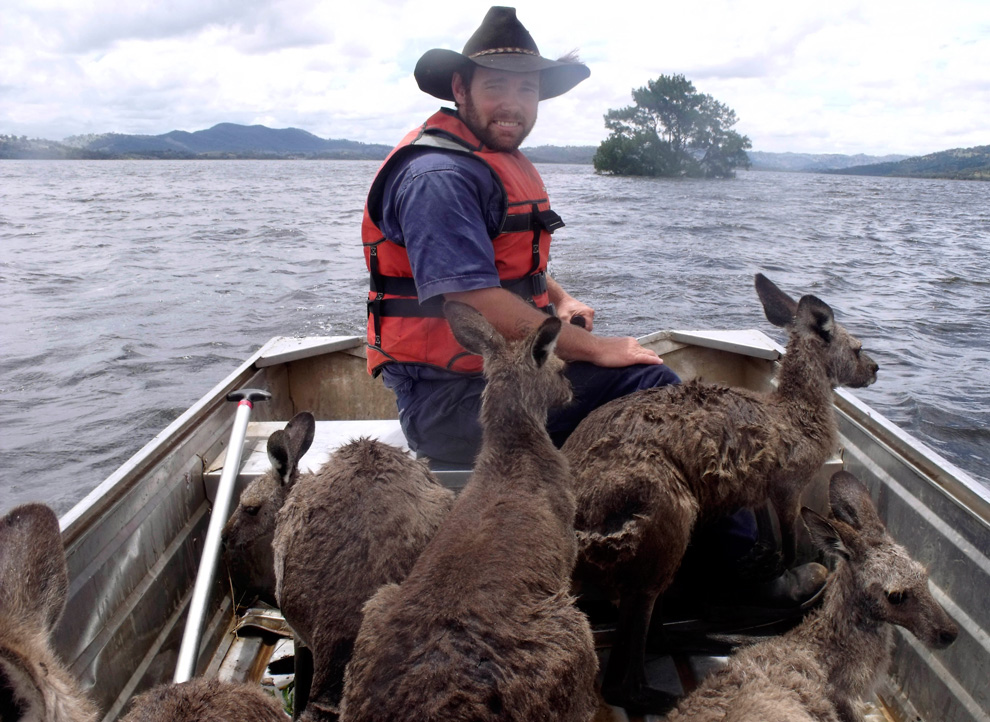 In the midst of the painful reports of severe flooding in Queensland, Australia, here is a picture of someone who cared enough to ferry a number of damp and anxious-looking kangaroos to safety. Any readers with more information about this rescue are asked to contact us.
In the midst of the painful reports of severe flooding in Queensland, Australia, here is a picture of someone who cared enough to ferry a number of damp and anxious-looking kangaroos to safety. Any readers with more information about this rescue are asked to contact us.
--Contributed by Marian Hussenbux
A Glimpse of the Peaceable Kingdom
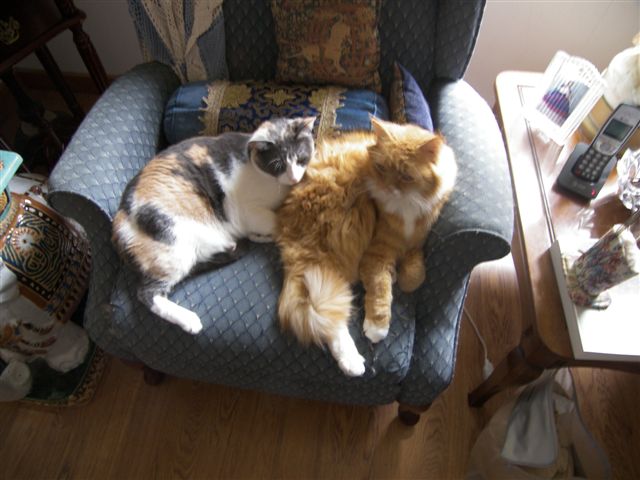
"Love Your Enemies . . .
and do them good" is generally agreed to be one of the hardest of spiritual counsels to follow. Yet some animals, such as Scoli, the little ginger cat above, apparently followed it without effort. Scoli was something like Tiny Tim, born with a deformed spine (hidden by his long fur) and respiratory problems, but radiating happiness and love to all. If another cat approached him hissing and ready to attack, Scoli would just survey the enemy calmly, then begun to lick her or his head. In this way he made all foes into lasting friends, notably a troubled, hostile calico named Messalina, shown above. Scoli purred when socializing with humans or other cats; he purred when sitting alone; he even purred in his sleep, manifesting a peace that surpasses our understanding.
--Gracia Fay Ellwood
Letter: Gerald Niles
. . . . Yes, animals have spiritual experiences, because every material body of an animal is inhabited by . . . two souls: the individual living entity, and the spirit of the Lord. We believe in that of God in everyone, in every sentient being.
I appreciate Bramwell Booth's poetic statement "And yet it [the dreadful violence] all lies between the verdant meadows and the dainty morsel on your plate" . . . .
Book Review: Wild Justice
Wild Justice : The Moral Lives of Animals. By Marc Bekoff and JessicaPierce. The University of Chicago Press, Chicago and London, 2009. 188 pages, hardcover. $26.oo.
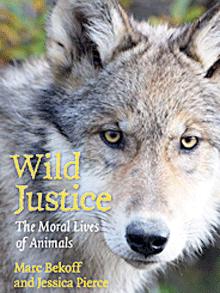 This milestone work is a collaboration between Marc Bekoff, a scientist who studies animal behavior (and whose work we have reviewed before on these pages,) and Jessica Pierce, a philosopher. Their thesis that there is such a thing as morality among wild animals is based on many observations. Among them are accounts of "pack" (or rather family) animals such as wolves, showing that they have definite rules governing their play, keeping it on the level of make-believe. Examples: mild nipping is okay, harmful biting is not; light sexual gestures are okay, serious sex is not; a larger and stronger animal handicaps him- or herself in order to play with a smaller and weaker one. The group takes the rules seriously; an animal who consistently breaks them is ostracized. The authors also tell stories of bats, cats, rats, elephants, monkeys, chimpanzees, dogs, and other animals who have shown kindness and compassion towards others. These others sometimes are even members of species others than their own. Does this show that animals have morality? Short answer: Yes.
This milestone work is a collaboration between Marc Bekoff, a scientist who studies animal behavior (and whose work we have reviewed before on these pages,) and Jessica Pierce, a philosopher. Their thesis that there is such a thing as morality among wild animals is based on many observations. Among them are accounts of "pack" (or rather family) animals such as wolves, showing that they have definite rules governing their play, keeping it on the level of make-believe. Examples: mild nipping is okay, harmful biting is not; light sexual gestures are okay, serious sex is not; a larger and stronger animal handicaps him- or herself in order to play with a smaller and weaker one. The group takes the rules seriously; an animal who consistently breaks them is ostracized. The authors also tell stories of bats, cats, rats, elephants, monkeys, chimpanzees, dogs, and other animals who have shown kindness and compassion towards others. These others sometimes are even members of species others than their own. Does this show that animals have morality? Short answer: Yes.
Before reaching this common-sense conclusion, the authors make a number of fine distinctions and clarifications. They point out that altruism isn't necessarily moral. Even the slime mold can behave altruistically; some slime mold cells die and become part of the stalks that support the living cells. The cells that behave in this manner have been programmed by Nature or God to act in this manner, and have no free will on the matter. (Pages 82-83). Still, it means we have no right to say, "What a selfish slime so-and-so is," because this is a slander against the real slime. Much less can we say, "The dirty rat" "he ratted us out," when we know that real rats have refused to give electric shocks to other rats, even if this meant going without food. By contrast, in the famous Milgram experiments, humans have been shown to give electric shocks to other humans on the urgent say-so of an authority figure, without even having to be told, "Press that button or there'll be no pizza for you."
Bekoff and Pierce also have to refute the objections of dogmatists (Aristotelians and Cartesians, styling themselves "skeptics"), who shout "Anthropomorphism!" to all studies concluding that animals have intelligence and feelings comparable to ours. On page 43 we read: "Wikipedia contains an entry for Anthropomorphobia - the fear or hatred of acknowledging in inhuman animals the qualities we want to consider distinctly human." Unfortunately, this entry no longer exists in the all-too-easily edited online encyclopedia. It has been deleted, perhaps by one of these very anthropomorphobes who does not want any alternative viewpoint to be even acknowledged.
The authors are a serious and careful scientist and scholar, and they repeatedly warn against facile theorizing and over-generalization. For example, they give evidence that even between chimpanzees and bonobos, who are almost 100% identical in their DNA, there are notable differences on the matters of reciprocity and mutual assistance. Bonobos usually and 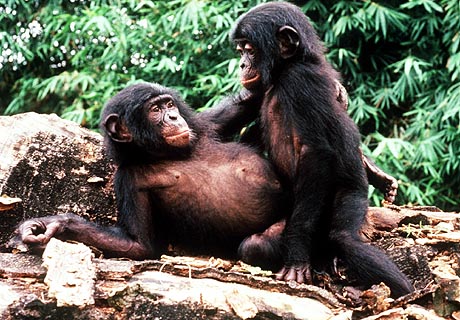
happily share food. Chimps, unless sharing is made easy for them, tend to hoard and to avoid sharing (pages 81-82). Yet chimpanzees are also capable of kindness and generosity, as shown by the story of Joni, a young chimpanzee with a bad habit of running up onto a roof. Neither bribes nor threats could get her down. Only one thing worked: Appealing to her compassion by crying (page 109). {This works with dogs as well. When a dog named Sara Puffy slipped her leash, the only way to get her back was to collapse on the ground, feigning helplessness, which would bring her running.)
I certainly commend this book to scientists, scholars, graduate students, and lay people with good educations and ample vocabularies. The less educated reader may be put off, or at least slowed down, by sentences such as: "Unfortunately, observation does not lead seamlessly to explanation." (Page 64). But this book needs to be known by everyone. Those who find it difficult should either resort to a dictionary, or scan the more theoretical passages and focus on the many fascinating stories about the fair play and the unselfish behavior of wonderful animals. For my part, I confess these stories more than make up for all the less riveting passages of speculation and cautious theorizing. Nevertheless, I do recommend to the authors that they prepare a version of this book in simpler English.
I would also like to see strong admonitions to many researchers to behave more morally themselves, following the examples of Bekoff and pioneers such as Nobelist Konrad Lorenz. It makes me weep to read about mice and rats who behave kindly and morally, only to be slain by calloused scientists who want to observe their brain cells under the microscope.
Further, I would also like to see some theological discussion. Does all morality come from God? Do the bat, cat, and rat who behave morally participate in a divine sense of justice? But that, probably, is another book.
--Benjamin Urrutia
Book Review: The Lost Dogs
Jim Gorant. The Lost Dogs: Michael Vick's Dogs and Their Tale of Rescue and Redemption. New York: Gotham Books, 2010. ix-xi +287. $26.00.
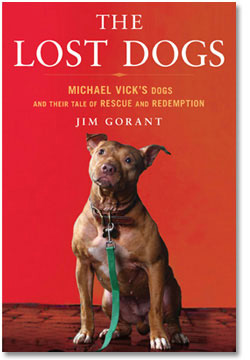 Jim Gorant is the journalist who reported for Sports Illustrated Magazine the sordid tale of football hero Michael Vick and his fall from grace: his prosecution, conviction and imprisonment for criminal acts related to dog-fighting. In Gorant’s new book, The Lost Dogs: Michael Vick’s Dogs and Their Tale of Rescue and Redemption, the entire grisly affair is more fully explored, and in gruesome detail.
Jim Gorant is the journalist who reported for Sports Illustrated Magazine the sordid tale of football hero Michael Vick and his fall from grace: his prosecution, conviction and imprisonment for criminal acts related to dog-fighting. In Gorant’s new book, The Lost Dogs: Michael Vick’s Dogs and Their Tale of Rescue and Redemption, the entire grisly affair is more fully explored, and in gruesome detail.
First and foremost, this book is misleadingly titled: it is not focused solely, or even primarily, on the reclamation of the abused pit bulls. Readers cannot open it expecting only a series of heartwarming tales about each dog’s rescue and recovery from the horrors inflicted at Vick’s torture and killing center known as “Bad Newz Kennelz” in Surrey County, Virginia. The spirit-lifting portions of the book are juxtaposed against the major portion, which tells the soul-crushing facts Gorant gathered as a journalist: the drowning, hanging, electrocution, and body slamming to death of multiple dogs, the investigation into that conduct, the evidence and testimony gathered, and the ultimate prosecution of Vick and his partners.
Particularly disturbing is the account of the social and political pressures to cover over the crimes because the perpetrator was Michael Vick, idolized athlete. The book reports on how the worship of celebrity in our society, the fear of being accused of discriminatory prosecution because of Vick’s race, combined with the social politics of “football mania” and money, nearly allowed Vick and his cohorts to continue to operate their hellhole out in the open, even after their ghastly conduct was discovered.
The book sets forth how courageous individuals who discovered the
horrible facts and persisted in taking action in the face of more powerful
opposition, ultimately resulted in the federal government stepping in
and prosecuting the case when it appeared that the state of Virginia
would not act. It was extremely disheartening to learn that one of the key advocates for the animals---the original state investigator who brought this matter to light---lost his job after Vick went to prison, from what appears to be political pressure related to the case.
It took me several weeks to slog through the horrific and graphic descriptions of the depravity and barbarity of this still celebrated football hero. Nevertheless, there is a place and a reason for reading it. As difficult as it is to face the facts showing that our society is ready to countenance the torture of animals if fame and celebrity are involved, or money can be made by a sports franchise, we must have the courage to read disturbing truths if those truths are ever to be changed.
Gorant has dispassionately reported the facts. Not only did he
interview the individuals who brought Vick to justice, he reviews the historical and sociological facts and myths about dog-fighting and “aggressive breeds.” He examines the law and the forensic, evidentiary and legal process itself; he describes the acts of torture and murder Vick undertook with his own hands, and his denials of his conduct until lie detector results, forensic evidence and the testimony of others forced him to negotiate a plea and avoid a trial. As we all know, he went to prison for a short time. The book highlights the legal maneuvers and public relations campaigns to rehabilitate his image: it shows shows who passed money to whom.
There is little in the book about acts of contrition by Vick or public statements showing remorse. This is apparently because they do not exist.
Michael Vick, his legal team, the orchestrated comeback and corporate
capitalists in the NFL are all revealed as morally bankrupt because
the bottom line is that there is money to be made from Vick’s athletic
prowess. Gorant’s book disproves the popular notion promoted by
Vick’s handlers, that he was simply a financial backer of the illegal
“sport” and is now a changed man. One who can read Gorant’s description of the little pit bull who Michael Vick personally body slammed to death and whose small mangled body was hidden in a separate grave, and the forensic scientist's chilling account of what this tortured animal endured, feels viscerally how much some strong evidence of repentance is needed.
Vick’s negotiated plea agreement included the payment of funds to cover the costs of maintaining the surviving dogs. The book relates how he failed to tender the agreed-upon payment until after the court issued an order to levy his bank accounts. This, coincidentally, was just after he indulged himself and his family in a lavish pre-incarceration spending spree of luxury items for all. Vick’s acts and statements as documented by Gorant, rather than expressing remorse, instead narcissistically focus on what he and his family suffered as a result of his conduct----his loss of freedom and money.
The event which finally propelled me to finish this difficult read and write this review was learning of Vick’s recently floated audacious idea
that he is the real victim----because a court order prohibits him from
owning a dog. Vick’s egocentric, looking-glass characterization of himself as victim is only trumped by the news that President Obama has recently thrown his support behind Vick, commending the owner of the Philadelphia Eagles for giving him a second chance.
The last third of the book includes bittersweet accounts and photographs of
the long, arduous, continuing process of rehabilitation for the rescued pit
bulls, as well as recitations of the huge obstacles encountered by those who wanted the dogs to survive and have a chance to be rehabilitated. Any such positive outcome is nothing short of miraculous when one considers that
they were so feared as “fighting dogs” as to be written off even by animal advocacy groups (which should know better), such as PETA and the Humane Society. They took the position that after the dogs' rescue and confinement in shelters for months to serve as “evidence” for the prosecution, the most humane disposition of them would be euthanasia. This is not giving the victims a second chance! Another reason for advocating euthanasia was to eliminate possible future liability if one of the “vicious fighting dogs” was involved in a violent incident thereafter.
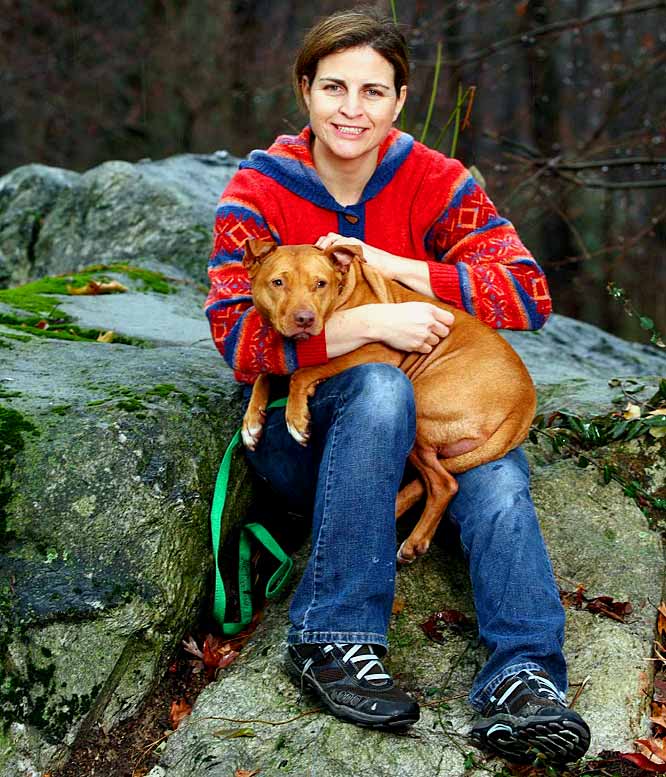
But they did get a second chance. This portion of the book profiles the work of the real heroes---those compassionate individuals and organizations (including Best Friends Animal Society) who took in and worked to heal the victims themselves. The dogs are amazingly resilient. Some of them have come so far as to earn Canine Good Citizen certifications or even Therapy Dog Certifications, and some now live in homes as loved family pets. Others still need further healing. These stories do much to erase unfair labels and stereotypes about the Vick pit bulls, as well as to change false notions about the breed itself. They show how rehabilitation can work healing for even the most abused of animals.
As hard as it is to read and contemplate all this, the story of the positive outcomes possible when human consciousness takes a different view and different actions regarding pit bulls, if not all animals, makes the book one which I wholeheartedly recommend.
--Cathy Hanan
Cathy Hanan is guardian of a rescued pit bull whose sweet personality and brown-sugar good looks are much admired when she takes Cathy or her other human for walks. Ms. Hanan is also a long-time supporter of Best Friends Animal Society and an attorney well aware of the difficulties, limitations and politics involved in every legal process, including criminal prosecutions.
Recipes
Lima Bean & Leek Soup
serves 4
1 lb. frozen baby lima beans
½ cup sliced leeks
1 carrot, peeled and diced
1 stalk celery, diced
1 T. chopped parsley
2 T. chopped cilantro (plus more for garnish)
½ tsp. dried thyme, crumbled
¼ tsp. ground dried rosemary
¼ cup Earth Balance® buttery substitute
4 cups filtered water
1 cup plain soymilk or almond milk
½ tsp. sea salt, or to taste
freshly ground black pepper, to taste
Sauté lima beans, leeks and carrots in Earth Balance until tender. Add herbs (except cilantro), stir with wooden spoon and cook for 2 minutes. Add water and sea salt. Bring to a boil, reduce heat and simmer for 20 minutes. Remove from heat. Allow to cool slightly. Purée in batches. Return to soup pot. Add soy (or almond) milk. Heat over low flame (or low heat) until warmed through. Add chopped cilantro. Serve immediately garnished with cilantro and vegan sour cream.
-- Angela Suarez
Berry Crumble
makes one 9-inch pie
1 lb. mixed frozen berries ( I often use a
combination of blueberries and red raspberries)
¼ tsp. sea salt
2 T. organic sugar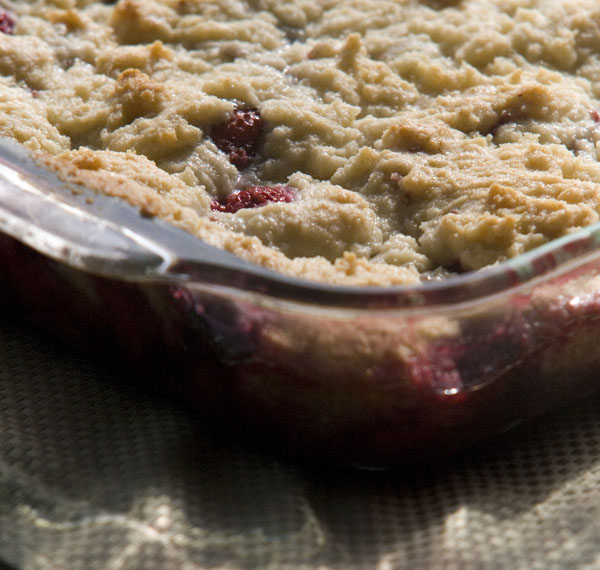
⅓ cup whole wheat flour
½ tsp. ground cinnamon
¼ tsp. sea salt
¼ cup brown sugar
¼ cup Earth Balance
1 cup quick oats
Preheat oven to 375° F. Spray a deep dish pie plate with non-stick cooking spray. Add berries; sprinkle with sea salt and sugar. In a small bowl toss together flour, cinnamon, sea salt and brown sugar. Sprinkle evenly over the berries. Dot with the Earth Balance. Sprinkle the oats over the top. Bake until berries are bubbling – about 40 minutes. Allow to cool slightly, but serve warm. Serve with vegan whipped topping or vegan sour cream
--Angela Suarez
Pioneer: Muriel Dowding, 1908-1993
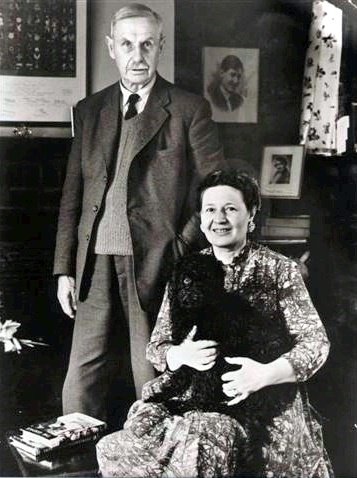 "Beauty Without Cruelty": these words sum up the greatest challenges and highest achievements in the life of Muriel Dowding. She was socially prominent as Lady Dowding, wife of Air Marshal Hugh Dowding, chief of the Royal Air Force's Fighter Command , whose brilliant deployment of limited planes and personnel was widely credited with saving Britain during the desperate days of 1940. But Muriel was far more than the lady of a baron and military hero. She was a strategist and fighter in her own right on behalf of animals.
"Beauty Without Cruelty": these words sum up the greatest challenges and highest achievements in the life of Muriel Dowding. She was socially prominent as Lady Dowding, wife of Air Marshal Hugh Dowding, chief of the Royal Air Force's Fighter Command , whose brilliant deployment of limited planes and personnel was widely credited with saving Britain during the desperate days of 1940. But Muriel was far more than the lady of a baron and military hero. She was a strategist and fighter in her own right on behalf of animals.
She was born Muriel Albino (also spelled Albini) in comfortable circumstances, but in a family divided between strong Protestant and Roman Catholic allegiances. Her parents separated when she was young; Muriel and her younger sister stayed with their mother for a time, and then with a couple named Epstein who had befriended Muriel earlier. She also attended a series of boarding schools. In one dramatic episode she and her sister, traveling unaccompanied by train, had to try to throw off private detectives her father's side of the family was thought to have set to follow them.
Amidst all this, Muriel grew up with considerable psychic and spiritual sensitivity. She saw fairies and ghosts, was instinctively inclined to vegetarianism from early childhood, and was deeply sensitive to the atmosphere of places, good or bad. She was most at her ease when she was with her mother, Hilda, who seems to have had had much the same gifts and personality. Perhaps in partial response to the conflicting family faiths, Hilda had become very active in the Theosophical Society, as later was Muriel; both were strongly committed to vegetarianism and kinship with animals. Muriel tells the story of how her mother had once gotten rid of rats in her house, not with poison or traps, but by talking to them in love and persuading them to leave. At first the rats all went into a neighbor's house-- hardly an ideal solution! But after that, Hilda -- and Muriel all her life -- would tells rats or other small unwanted house-guests she would put out food for them in some neutral place outdoors, and to go get it there.
Blossoming as a vivacious young woman, Muriel seems to have been irresistible to males. She enjoyed an unending series of fervent suitors and a sequence of short engagements, which she terminated as she realized each was not truly the man for her. (She had had dreams in which there appeared a tall, slim man who calmed her nightmares, a man mature and reliable yet also loving and exciting; later she realized this was Hugh Dowding.) But in her autobiography she acknowledges she was then something of a heartbreaker, a "spoilt" young woman with little concern but for her own feelings and fancies -- beauty with cruelty. She finally married Max Whiting, the most persistent of all her many admirers. The marriage was troubled, partly, as she again recognized, because of her self-centered character, and partly because of his drinking and tendency to depression.
Then came the war, and Max joined the Bomber Command of the Royal Air Force. Shot down in 1944 over German-occupied Denmark, he was long listed as missing in action; Muriel's love and concern for her husband had by then recovered sufficiently that "missing" caused her acute anguish. When Max was finally declared dead, she was desperate for solace. She heard that Lord Dowding, himself deeply troubled by thoughts of the many fine young airmen who had lost their lives to the demons of battle, responded sympathetically to bereaved parents and widows who contacted him. Dowding had, in fact, attempted to understand death better through the study of spiritualism, and had written a book, Many Mansions, based on this research. The retired Air Marshall answered Muriel courteously, asking for more information about Max.
To Muriel's surprise, a later letter told her he believed a medium with whom he worked had contacted Max, and that she was invited to come to London to meet him and the medium. Eager for any news of Max, she rushed to town. She was not overly impressed with the medium, but found the occasion led into lunch with Dowding and finally an all-afternoon chat with him at his club.
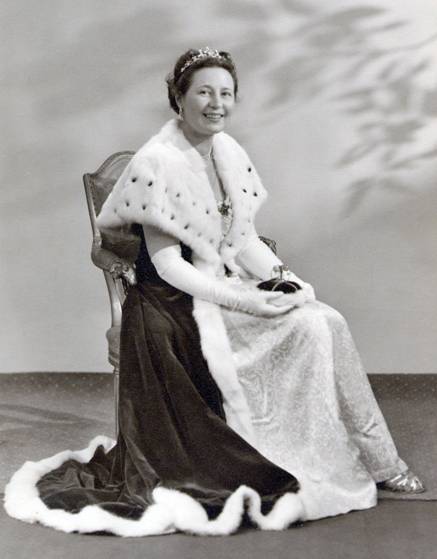
It soon became apparent that Dowding, a widower since 1920 after only two years of marriage, was very much smitten by the young widow. Invitation followed invitation, then marriage in 1953, and Muriel became Lady Dowding (seen here in the robes she wore for the coronation of Queen Elizabeth II). Beauty was now without cruelty; they were tremendously happy, and Muriel led Hugh, already open to spiritualism and Theosophy, to the animal concern and thus to vegetarianism. She encouraged him to use his status as a member of the House of Lords to make speeches and support legislation on their behalf, which he eagerly did.
Muriel herself used her enhanced social position to advance these same causes. Warm, open-hearted, and charismatic, she was a natural leader. She was no less willing to work hard, travel widely, and unpack boxes than to preside and lecture (which she disliked despite her willingness to do so on behalf of her beloved cause). She demonstrated against fur coats, at that time very fashionable; she served enthusiastically as vice president of the Royal Society for the Prevention of Cruelty to Animals and as president of the National Anti-Vivisection Society. She held regular Sunday luncheon parties at her estate to introduce vegetarian cuisine to influential people.
She became best known, however, for Beauty Without Cruelty. Muriel was shocked to learn, in the early sixties, that -- although it was supposed to be a trade secret -- cosmetic companies tested their products on animals, often in appalling ways, as well as using animal ingredients, such as whale oil and musk, obtained in a no less ruthless manner. She tried to persuade the industry to change, but without success. Her decision then was not just to protest, but to provide a constructive alternative. A friend, Kathleen Long, who had an education in chemistry, was sure it was possible to make cosmetics without animal testing or ingredients. With the support of Hugh Dowding, together they founded Beauty Without Cruelty, not to make money, which at first they rarely did, but as an educational tool. Hugh Dowding remained a devoted benefactor until his death in 1970.
For the remaining twenty-three years of her life, Muriel continued to
commit her vast resources of charm, energy, and enthusiasm to a cause beyond herself, that of befriending animals so often cruelly exploited, and who usually have no voice but ours. Beauty Without Cruelty was her particular vehicle, perhaps one that especially reflected her own nature. Its products, and that of other cosmetics like them that proudly proclaim, "Not tested on animals" and "No animal ingredients," are now found world-wide and sought by millions of caring women.
Muriel, Lady Dowding, was an inspiring and pioneering figure. May there be many more like her in an age that calls for persons of her inner and outer beauty to dream, and then to do.
--Robert Ellwood
Source: Muriel Dowding, The Psychic Life of Muriel, The Lady Dowding. Wheaton, IL: Theosophical Publishing House, 1980. Published in Britain as Beauty -- Not the Beast: An Autobiography, by Neville Spearman, Inc., 1980.
Our thanks to David Whiting for permission to use the photograph of his mother in her robes for the coronation.
Poetry: John Clare, 1793-1864
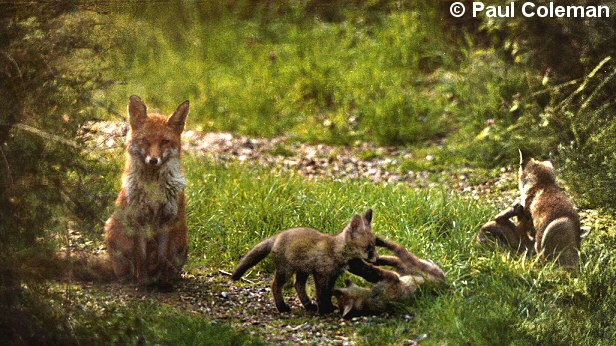
The Vixen
Among the taller wood with ivy hung,
The old fox plays and dances round her young.
She snuffs and barks if any passes by
And swings her tail and turns prepared to fly.
The horseman hurries by, she bolts to see,
And turns agen, from danger never free.
If any stands she runs among the poles
And barks and snaps and drive them in the holes.
The shepherd sees them and the boy goes by
And gets a stick and progs the hole to try.
They get all still and lie in safety sure,
And out again when everything’s secure,
And start and snap at blackbirds bouncing by
To fight and catch the great white butterfly.
Photo of fox and cubs by Paul Coleman. Used with permission of Paul Coleman and Wildlife Online, http://www.wildlifeonline.me.uk/ .
The Peaceable Table is
a project of Quaker Animal Kinship / Animal Kinship Committee of Orange Grove Friends Meeting, Pasadena, California. It is intended to resume the witness of that excellent vehicle of the Friends
Vegetarian Society of North America, The Friendly
Vegetarian, which appeared quarterly between 1982 and
1995. Following its example, and sometimes borrowing from its
treasures, we publish articles for toe-in-the-water
vegetarians as well as long-term ones.
The journal is intended to be
interactive; contributions, including illustrations, are
invited for the next issue. Deadline for the April issue
will be March 28, 2011. Send to graciafay@gmail.com
or 10 Krotona Hill, Ojai, CA 93023. We operate primarily
online in order to conserve trees and labor, but hard copy
is available for interested persons who are not online.
The latter are asked, if their funds permit, to donate $12 (USD) per year. Other
donations to offset the cost of the domain name and server are welcome.
Website: www.vegetarianfriends.net
Editor: Gracia Fay Ellwood
Book and Film Reviewers: Benjamin Urrutia & Robert Ellwood
Recipe Editor: Angela Suarez
NewsNotes Editors: Lorena Mucke and Marian Hussenbux
Technical Architect: Richard Scott Lancelot Ellwood

 For about 36 years I have practiced the vegetarian way of life, and I thank God for what it has done for me. It has given me a light and clear head, a tranquil body and spirit. I have never experienced a single day of sickness or even a slight indisposition. At 78 I continue to work regularly at an editorial job. I can walk long distances, covering 20 miles in less than five hours
For about 36 years I have practiced the vegetarian way of life, and I thank God for what it has done for me. It has given me a light and clear head, a tranquil body and spirit. I have never experienced a single day of sickness or even a slight indisposition. At 78 I continue to work regularly at an editorial job. I can walk long distances, covering 20 miles in less than five hours  with relative ease. I rejoice in being in the company of such great men of history as Socrates, Plato, Zoroaster, Buddha, Jesus, Leonardo da Vinci, Franklin, Newton, Shelley, Tolstoy, Gandhi, . . . and I believe at least one outstanding woman, Susan B. Anthony, a Quaker.
with relative ease. I rejoice in being in the company of such great men of history as Socrates, Plato, Zoroaster, Buddha, Jesus, Leonardo da Vinci, Franklin, Newton, Shelley, Tolstoy, Gandhi, . . . and I believe at least one outstanding woman, Susan B. Anthony, a Quaker. "[God says,] "I was a hidden treasure and desired to be known, so I created the Creation; and through Me they knew Me."
"[God says,] "I was a hidden treasure and desired to be known, so I created the Creation; and through Me they knew Me."
 In the midst of the painful reports of severe flooding in Queensland, Australia, here is a picture of someone who cared enough to ferry a number of damp and anxious-looking kangaroos to safety. Any readers with more information about this rescue are asked to contact us.
In the midst of the painful reports of severe flooding in Queensland, Australia, here is a picture of someone who cared enough to ferry a number of damp and anxious-looking kangaroos to safety. Any readers with more information about this rescue are asked to contact us. 
 This milestone work is a collaboration between Marc Bekoff, a scientist who studies animal behavior (and whose work we have reviewed before on these pages,) and Jessica Pierce, a philosopher. Their thesis that there is such a thing as morality among wild animals is based on many observations. Among them are accounts of "pack" (or rather family) animals such as wolves, showing that they have definite rules governing their play, keeping it on the level of make-believe. Examples: mild nipping is okay, harmful biting is not; light sexual gestures are okay, serious sex is not; a larger and stronger animal handicaps him- or herself in order to play with a smaller and weaker one. The group takes the rules seriously; an animal who consistently breaks them is ostracized. The authors also tell stories of bats, cats, rats, elephants, monkeys, chimpanzees, dogs, and other animals who have shown kindness and compassion towards others. These others sometimes are even members of species others than their own. Does this show that animals have morality? Short answer: Yes.
This milestone work is a collaboration between Marc Bekoff, a scientist who studies animal behavior (and whose work we have reviewed before on these pages,) and Jessica Pierce, a philosopher. Their thesis that there is such a thing as morality among wild animals is based on many observations. Among them are accounts of "pack" (or rather family) animals such as wolves, showing that they have definite rules governing their play, keeping it on the level of make-believe. Examples: mild nipping is okay, harmful biting is not; light sexual gestures are okay, serious sex is not; a larger and stronger animal handicaps him- or herself in order to play with a smaller and weaker one. The group takes the rules seriously; an animal who consistently breaks them is ostracized. The authors also tell stories of bats, cats, rats, elephants, monkeys, chimpanzees, dogs, and other animals who have shown kindness and compassion towards others. These others sometimes are even members of species others than their own. Does this show that animals have morality? Short answer: Yes.
 Jim Gorant is the journalist who reported for Sports Illustrated Magazine the sordid tale of football hero Michael Vick and his fall from grace: his prosecution, conviction and imprisonment for criminal acts related to dog-fighting. In Gorant’s new book, The Lost Dogs: Michael Vick’s Dogs and Their Tale of Rescue and Redemption, the entire grisly affair is more fully explored, and in gruesome detail.
Jim Gorant is the journalist who reported for Sports Illustrated Magazine the sordid tale of football hero Michael Vick and his fall from grace: his prosecution, conviction and imprisonment for criminal acts related to dog-fighting. In Gorant’s new book, The Lost Dogs: Michael Vick’s Dogs and Their Tale of Rescue and Redemption, the entire grisly affair is more fully explored, and in gruesome detail.

 "Beauty Without Cruelty": these words sum up the greatest challenges and highest achievements in the life of Muriel Dowding. She was socially prominent as Lady Dowding, wife of Air Marshal Hugh Dowding, chief of the Royal Air Force's Fighter Command , whose brilliant deployment of limited planes and personnel was widely credited with saving Britain during the desperate days of 1940. But Muriel was far more than the lady of a baron and military hero. She was a strategist and fighter in her own right on behalf of animals.
"Beauty Without Cruelty": these words sum up the greatest challenges and highest achievements in the life of Muriel Dowding. She was socially prominent as Lady Dowding, wife of Air Marshal Hugh Dowding, chief of the Royal Air Force's Fighter Command , whose brilliant deployment of limited planes and personnel was widely credited with saving Britain during the desperate days of 1940. But Muriel was far more than the lady of a baron and military hero. She was a strategist and fighter in her own right on behalf of animals.
